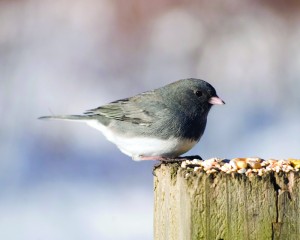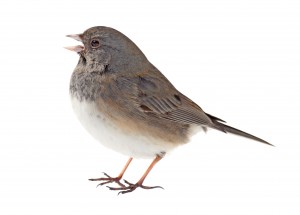 Identification
Identification
At first glance you may shrug off the diminutive Dark-eye Junco as a bland-colored bird. But upon closer inspection you’ll note that the sleek darker top softly fades to a downy white underbelly. And, if you look real closely, you’ll see that juncos have one of the prettiest beaks; a gorgeous shell-pink that contrasts nicely with its dark hood. When driving your car along rural roads, the sudden flash of white outer tail feathers will confirm you just startled a flock of juncos.
There are five forms, with two other identities possibly becoming forms in the near future. In the Midwest, the Dark-eyed Junco is our “snowbird,” usually arriving six weeks prior to our first significant snowfall. Go ahead: keep an annual log and see how accurate this old wive’s tale is!
 Range
Range
Some form of junco can be found in nearly every state. The slate-colored form can be found throughout Central North America from Alaska south to Texas and east. During the summer months, this form breeds across Canada and into Alaska. It also can be found year-round in the very Northeast tip of Minnesota, near the BWCA (Boundary Waters Canoe Area).
Diet
Fruit and insects are the preferred diet, but slate-colored juncos are feeder birds as well. In fact, during the winter months they are traditionally the most common feeder bird throughout the Midwest. Seeds of choice include millet and Nyjer®.

